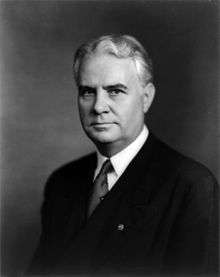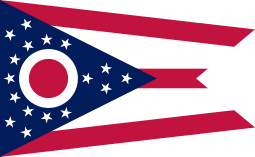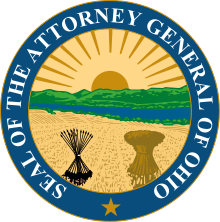John W. Bricker
| John W. Bricker | |
|---|---|
 | |
| United States Senator from Ohio | |
|
In office January 3, 1947 – January 3, 1959 | |
| Preceded by | Kingsley A. Taft |
| Succeeded by | Stephen M. Young |
| 54th Governor of Ohio | |
|
In office January 9, 1939 – January 8, 1945 | |
| Lieutenant | Paul M. Herbert |
| Preceded by | Martin L. Davey |
| Succeeded by | Frank J. Lausche |
| Ohio Attorney General | |
|
In office 1933–1937 | |
| Preceded by | Gilbert Bettman |
| Succeeded by | Herbert S. Duffy |
| Personal details | |
| Born |
John William Bricker September 6, 1893 Mount Sterling Madison County Ohio, USA |
| Died |
March 22, 1986 (aged 92) Columbus, Ohio, USA |
| Resting place |
Green Lawn Cemetery Columbus, Ohio |
| Political party | Republican |
| Spouse(s) | Harriet Day Bricker |
| Residence | Columbus, Ohio |
| Alma mater | Ohio State University |
| Profession | Lawyer |
| Religion | Congregationalist |
| Military service | |
| Service/branch | United States Army |
| Battles/wars | World War I |
John William Bricker (September 6, 1893 – March 22, 1986) was a United States Senator and the 54th Governor of Ohio. A member of the Republican Party, he was the Republican nominee for Vice President in 1944.
Early life
Bricker was born on a farm near Mount Sterling in Madison County in south central Ohio. He was the son of Laura (née King) and Lemuel Spencer Bricker.[1] He attended Ohio State University at Columbus, where he divided his time between the debating team, the varsity baseball team,[2] and the Delta Chi Fraternity. After graduating with a Bachelor of Arts from Ohio State in 1916 and from its law school in 1920, he was admitted to the bar in 1917 and began his legal practice in Columbus in 1920.[3]
He was married to the former Harriet Day.
Public service
During World War I, Bricker served as first lieutenant and chaplain in the United States Army in 1917 and 1918. He was subsequently the solicitor for Grandview Heights, Ohio, from 1920 to 1928, assistant Attorney General of Ohio from 1923 to 1927, a member of the Public Utilities Commission of Ohio from 1929 to 1932, and Attorney General of Ohio from 1933 to 1937.
He was elected governor for three two-year terms, serving from 1939 to 1945, having each time won with a greater margin of victory.[2] Bricker espoused a stance against centralized government, preferring to increase involvement in state and local governments, and made this known in his inaugural address as Governor:
There must be a revitalization of state and local governments throughout the nation. The individual citizen must again be conscious of his responsibility to his government and alert to the preservation of his rights as a citizen under it. That cannot be done by taking government further away, but by keeping it at home.— John W. Bricker, inaugural gubernatorial address, January 9, 1939.[2]
Bricker was the 1944 Republican nominee for vice president, having run with presidential nominee Thomas E. Dewey, the governor of New York who was nine years Bricker's junior. The Republicans lost handily to the Democratic ticket of Franklin D. Roosevelt and Harry S. Truman. In that campaign, Bricker proved to be a tireless campaigner. He visited thirty-one states and made 173 speeches, including 28 over a six-day period. His final remarks came on radio on election eve from the governor's office in Columbus, when he declared: "Not only has the New Deal depleted our resources, recklessly spent our money, but it has undermined the very spiritual foundations of our government."[4] Though most of his campaigning was in New England, the Middle West, and the American West, Bricker even visited the then-historically and -heavily Democratic state of Texas, where in Dallas, he called Franklin Roosevelt "a front for the Hillman-Browder Communist Party," referring to the respective leaders of the Congress of Industrial Organizations labor union and the Communist Party of the United States of America political party.[5]
In 1946, Bricker was elected to the United States Senate. He was re-elected in 1952, serving from January 3, 1947, to January 3, 1959.
Governor Dewey was the Republican presidential nominee again in 1948, but Senator Bricker was not his running mate. Dewey chose instead Governor Earl Warren of California in the hope that the 1948 ticket would carry California, which the Dewey-Bricker ticket had failed to do. The Dewey-Warren ticket also lost California, and the absence of Bricker on the second ticket may have been a factor in Dewey's failure to win Bricker's home state of Ohio again. Bricker had campaigned with Warren in 1944 in Sacramento, where Bricker attacked the politics of war-time rationing; then in San Francisco Bricker charged that Roosevelt had packed the U.S. judiciary with liberal jurists hostile to the Constitution.[5] However, even if Dewey had carried both California and Ohio in 1948, the two large states would have been insufficient to elect him President in that second campaign.
Bricker's Senate service is best remembered for his attempts to amend the United States Constitution to limit the President's treaty-making powers (the Bricker Amendment). He was the chairman of the Committee on Interstate and Foreign Commerce during the 83rd Congress.
On July 12, 1947, a former Capitol police officer fired shots at Senator Bricker as he boarded the underground trolley from the Senate office building to the Capitol. The two shots, fired as close range, narrowly missed the target.[6]
In 1958, Stephen M. Young ran for the Senate against the incumbent Bricker. Bricker seemed invincible, but Young capitalized on widespread public opposition to the proposed "right to work" amendment to Ohio's constitution, which Bricker had endorsed. Few thought that Young, 70 at the time, could win; even members of his own party had doubts, particularly Ohio's other senator, Democrat Frank J. Lausche. In an upset amid a national Democratic trend, Young defeated Bricker by 52 to 48 percent. Bricker then retired from public life.
Professional life
In 1945, Bricker founded the Columbus law firm now known as Bricker & Eckler. The firm now has additional offices in Cleveland and West Chester, Ohio. The West Chester office serves the cities of Cincinnati and Dayton. "Bricker" is now one of the ten largest firms in the state of Ohio.
After leaving the Senate, John Bricker resumed the practice of law. He died in Columbus on March 22, 1986 at the age of ninety-two and is interred there at Green Lawn Cemetery.
Miscellaneous
- Bricker Hall on the Ohio State University campus is named for him. The building currently serves as the home of many of the university administrative units, including the Office of the Board of Trustees and President Dr. Michael V. Drake. Bricker was a member of the OSU Board of Trustees from 1948 to 1969.[7]
- The Bricker Building at the Ohio Expo Center (site of the annual Ohio State Fair and many other events) is named for him.
- In Philip K. Dick's 1962 novel The Man in the High Castle, set in an alternate timeline, Bricker succeeded John Nance Garner as the 33rd President of the United States in 1940.
Notes
- ↑ Lawrence Kestenbaum. "Optimist Club, politicians". The Political Graveyard. Retrieved 2016-10-04.
- 1 2 3 Ohio Fundamental Documents: John Bricker
- ↑ accessed 5-29-10
- ↑ David M. Jordan, FDR, Dewey, and the Election of 1944 (Blomington: Indiana University Press, 2011), pp. 294, 296-297, ISBN 978-0-253-35683-3
- 1 2 David Jordan, p. 295
- ↑ Former Capitol Policeman Shoots at Senator (2012-01-04). "Former Capitol Policeman Shoots at Senator". Ghosts of DC. Retrieved 2016-10-04.
- ↑ "Campus Connections, Bricker Hall" (PDF). The Ohio State University, Physical Facilities. Archived from the original (PDF) on September 2, 2006. Retrieved October 28, 2006.
External links
| Wikimedia Commons has media related to John W. Bricker. |
- United States Congress. "John W. Bricker (id: B000820)". Biographical Directory of the United States Congress.
| Offices and distinctions | |||||||||||||||||||||||||||
|---|---|---|---|---|---|---|---|---|---|---|---|---|---|---|---|---|---|---|---|---|---|---|---|---|---|---|---|
\
| |||||||||||||||||||||||||||



